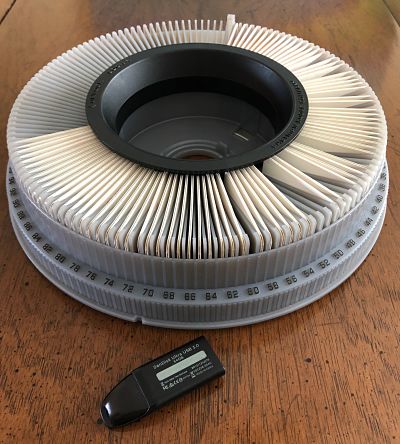The square, black and yellow boxes hide in a corner of our dining room. Relics of the pre-digital era, they contain Kodak slide carousels, those circular containers with 80 or 140 slots for 35 mm slides which are mounted upside down and backwards for projection purposes. I say they are hiding because they know that soon we are going to go through them, choose the few worth transferring to digital format and then trash the rest.
I rotate and click in place a carousel on our old Kodak projector, mentally drifting back to the early years of my radiology career at the University of California, San Diego (UCSD).
Our department put on a lot of continuing medical education courses at the Hotel Del Coronado, a popular, world class venue. I’d paste a smile on my face as I drove up to the hotel entrance and showed them my adaptive driving device to explain why they should let me self-park the car. Then another extra-nice smile as I asked for someone to carry the two or three boxes of slide carousels to whatever auditorium our meeting was being held in. In the early years, there was not an elevator to the big hall so I’d clunk along behind an employee with my toy-soldier gait and cane along the “rainy-day walkway”. I swear, this route was at least a quarter of a mile long.
As a disabled radiologist, missing both legs above the knee and my right arm, slide carousels were a pain in the butt. A 50 minute lecture might have 30 or 40 slides with a combination of x-ray images and word slides, all which fit into these pesky carousels.
In retirement, the focus of my talks has changed. Instead of teaching radiology with chest X-rays and mammograms, they are motivational and more personal. The slides show me as a triple amputee–raising a family, wilderness camping, traveling, butt-walk racing. Anything I can use to connect with people dealing with disabilities or illnesses, in particular, Parkinson’s Disease. According to my rough calculations, now days a typical thumb drive with 62 GB of memory can store about 775 carousels of lectures. Those would probably fill up my dining room and living room. Amazing!
Still musing, I push the projector’s ON button and an image appears on our dining room wall. I giggle as a thirty-year-old memory reruns in my mind. In it, I’m coming to the end of a lecture on chest trauma at the Hotel Del when I glance over my shoulder to make sure I’m talking in sync with my slides. I do a double take and pause for a second…is that slide upside down? I back up one slide- that one’s ok. Pressing the clicker, the same upside-down slide returns to the huge screen. Thinking fast, as my voice trails down, I advance to the next slide. Uh-oh, this one is upside-down AND backwards. I take a deep breath as the next to last slide comes up…backwards.
In my mind, I hear the deep voice of my mentor, Dr. Ike Sanders. “Linda, if something goes wrong during a talk, don’t make excuses, just keep on going.”
I turn back to the audience, take a deep breath and roll my eyes. “I’m not sure, but I’m wondering if my 5 year old son may have been checking out my slides last night. What do you think?”
Laughter broke out as I finished the talk with, “This is what happens when you let moms be radiologists.”


Love it. I still have carousels somewhere
I remember those days!!
And I also remember attending a Refresher course at Del Coronado.
This one is a nice trip down memory lane Linda!
Lots of love
Linda, I have enjoyed all of your posts. Can’t wait for one from your Japan visit. Love from SC.
I remember those slides! Maybe I typed them upside down? It’s so amazing how far technology’s come from typing up text slides and having them photographed by a photographer.
You would never have typed anything upside down. You were one of the best!
Fun and all too true! Needless to say, we didn’t keep Sid’s numerous slides!
Loved this and as always your humor in any situation.
One of the many reasons I gave up formal lectures in mid career. Thanks for reminding me of one of my few triumphs.
Nice walk down memory lane! Ours are still in little yellow boxes, in metal boxes with little metal file markers, in long narrow plastic projector boxes. I ditched the carousels, but kept one for more efficient editing. It’s a pain but with a glass of wine, my husband and I make it movie night and edit out the good ones. Laughing and crying for the past adventures. I send the “keepers” away to be digitized, 600 at a time. Worth it!
I love the way you write and your sense of humor. It’s inspiring to me! As to lectures, Keith learned long ago not to try humor in an international lecture–it just doesn’t translate well.
Another wonderful episode.
As usual your sense of humor carries the day. Your way in the world inspires me.
But alas, lazy me, I’m not to cull my photos yet.
I remember those slide years. It was so easy to get them backwards or in the wrong order. I don’t know how you did it. But then, I don’t know how you did a lot of things. I’ve learnt from you and I keep on learning.
Wonderful walk down memory lane. Our boxes of slides are still waiting attention. I’m once again inspired by you and will plan a movie night.
Linda, that made me giggle! What a cute story. Thanks for putting a smile on my face this morning. Brilliant writing!!
Loved your story as always. Makes me smile every time.
Took a while to get to this, but so worthwhile. Keep it up, love your joie de vivre.